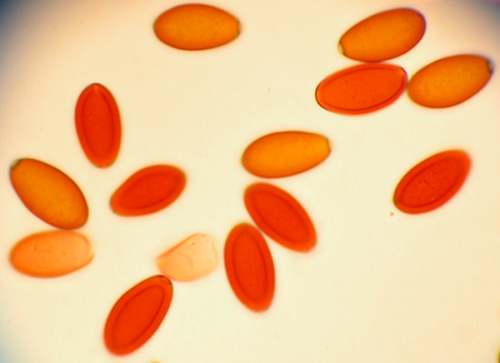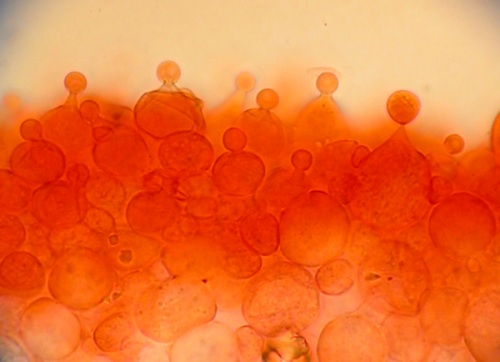Conocybe tenera (Schaeff.) Fayod - Common Conecap
Phylum: Basidiomycota - Class: Agaricomycetes - Order: Agaricales - Family: Bolbitiaceae
Distribution - Taxonomic History - Etymology - Identification - Culinary Notes - Reference Sources
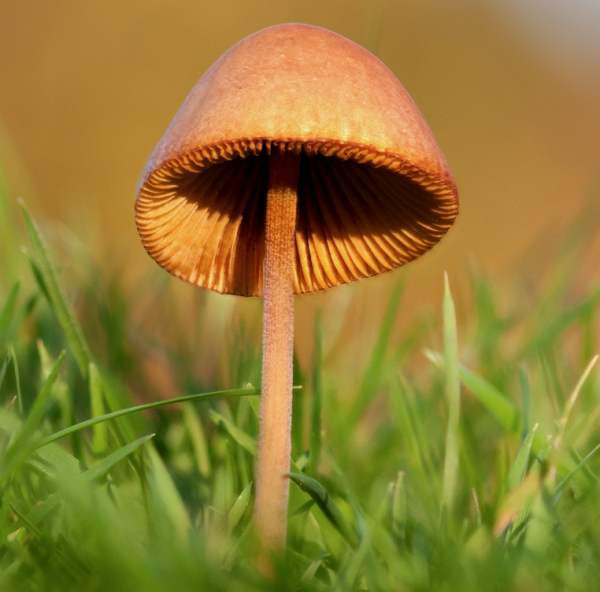
Conecaps are neat little mushrooms, but some species in this group are poisonous. For this reason small children should not be allowed to play with or near to Conocybe species.
Close-cropped grassland such as lawns, golf courses, parks and dune slacks seems to suit these conecaps well, but they can also appear on leaf litter, sawdust and woodchip mulch as well as on disturbed nutrient-rich soil in parks, orchards and gardens.
Distribution
Conocybe tenera is fairly common and widespread throughout Britain and Ireland as well as on mainland Europe. This grassland mushroom is also found in many parts of North America.
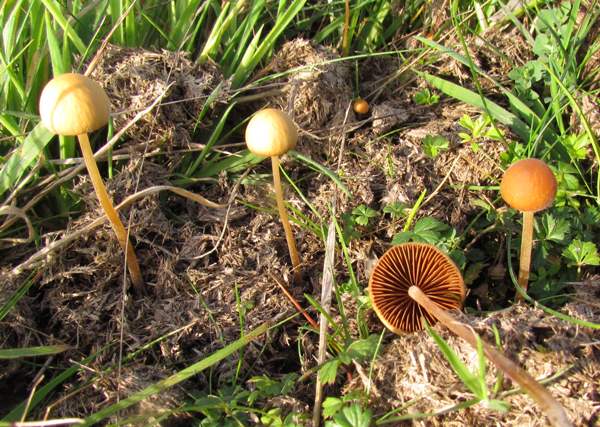
Taxonomic history
The Common Conecap was described in 1762 by the pioneering German mycologist Jacob Christian Schaeffer, who named it Agaricus tener. At that time most gilled fungi were placed initially in one gigantic Agaricus genus, whose contents have since largely been redistributed to other newer genera.
A delicate grassland and woodland-edge conecap, this species was transferred to its present genus by the Swiss mycologist Victor Fayod (1860 - 1900), at which point its binomial name became Conocybe tenera.
Synonyms of Conocybe tenera include Agaricus tenera Schaeff., Galera tenera (Schaeff.) P. Kumm., Galera tenera f. typica Kühner, Galera tenera f. microspora J. E. Lange, and Galera tenera f. tenella J. E. Lange.
Etymology
The generic name Conocybe comes from the Latin Conus meaning a cone, and cybe meaning a head - hence 'with a conical head', or in other words conecap. Less obviously, the specific epithet tenera comes from the Latin tener and means tender or delicate, an appropriate description for this and other members of the genus Conocybe, which are extremely fragile.
Identification guide
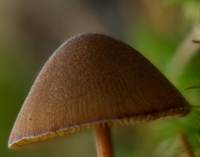 |
Cap1 to 3cm in diameter, the caps are conical at first, becoming bell-shaped with very faint marginal striations. The surface is smooth, dry and ochre-brown to cinnamon or rust-brown; hygrophanous, becoming yellowish in prolonged dry weather, eventually turning pale beige, with a weakly-lined margin. |
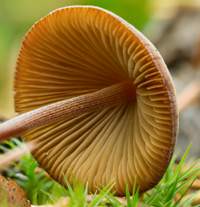 |
GillsThis attractive conecap has adnexed gills. Initially very pale ochre, the crowded gills become cinnamon or rust coloured as the spores mature; the gill edges are noticeably paler than the gill faces. StemSlender straight stems of Conocybe tenera are level, 4 to 7mm in diameter and 5 to 9cm long, white flushed with rusty brown and finely granular; becoming hollow and very fragile. There is no stem ring
|
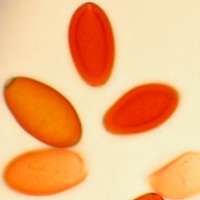 |
SporesEllipsoidal, smooth, 9-14 x 5-8 μm; thick-walled, with a broad germ pore. Spore printRust-brown. BasidiaFour-spored. |
 |
Cheilosystidia (gill-edge cystidia)The cheilolocystidia are all lecythiform (shaped like bowling pins). |
Odour/taste |
Not distinctive. |
Habitat & Ecological role |
Saprobic, appearing on lawns, in parks and on other close-cropped manured grassland, occasionally on woodchip mulch; also on leaf litter on woodland edges; generally in scattered groups but occasionally solitary. |
Season |
May to September in Britain and Ireland. |
Similar species |
Conocybe apala, the Milky Conecap, is a much paler, more sharply conical mushroom that appears briefly on lawns after rain. |

Culinary Notes
Some field guides record the Common Conecap as 'inedible', and possibly poisonous. With its small size and thin flesh, this delicate and very fragile mushroom would hardly be worth gathering even if it were a good edible species, and so Conocybe tenera is probably best left for the lawnmower to devour.
Reference Sources
Fascinated by Fungi, 2nd Edition, Pat O'Reilly 2016, reprinted by Coch-y-bonddu Books in 2022.
Watling, R. (1982). British Fungus Flora: Agarics and Boleti. Vol 3. Bolbitiaceae: Agrocybe, Bolbitius, & Conocybe. Royal Botanic Garden, Edinburgh, Scotland.
Dictionary of the Fungi; Paul M. Kirk, Paul F. Cannon, David W. Minter and J. A. Stalpers; CABI, 2008
Taxonomic history and synonym information on these pages is drawn from many sources but in particular from the British Mycological Society's GB Checklist of Fungi.
Acknowledgements
This page includes photographs kindly contributed by David Kelly.
Fascinated by Fungi. Back by popular demand, Pat O'Reilly's best-selling 450-page hardback book is available now. The latest second edition was republished with a sparkling new cover design in September 2022 by Coch-y-Bonddu Books. Full details and copies are available from the publisher's online bookshop...
